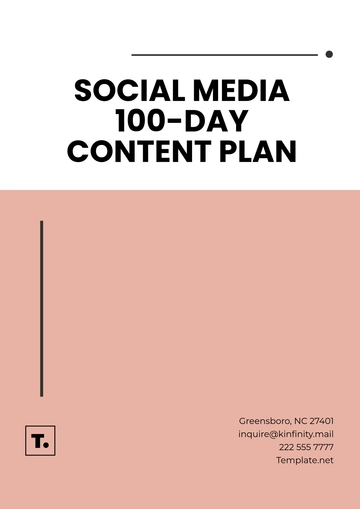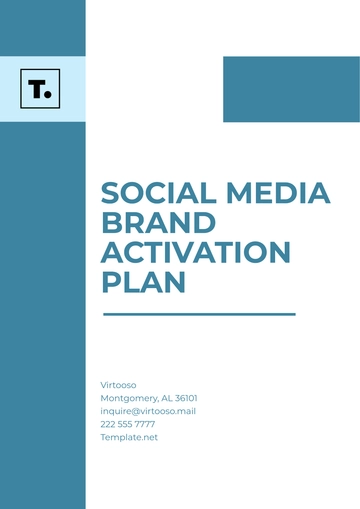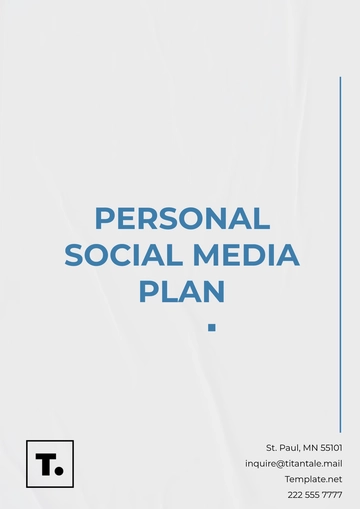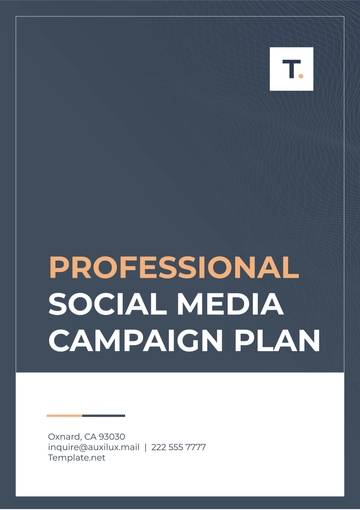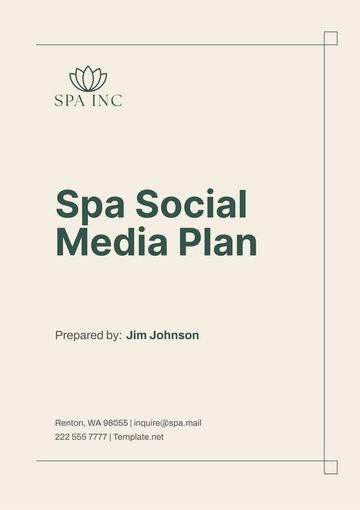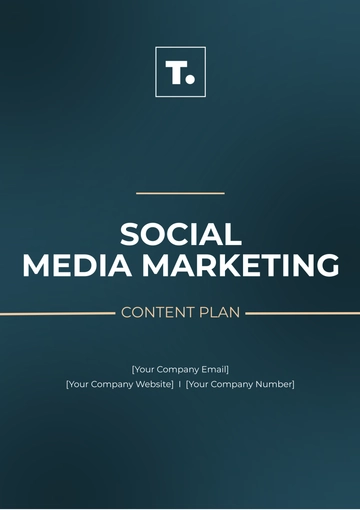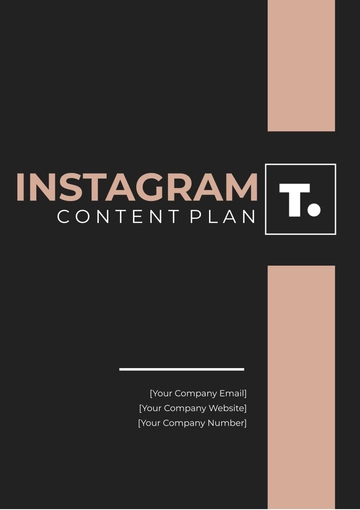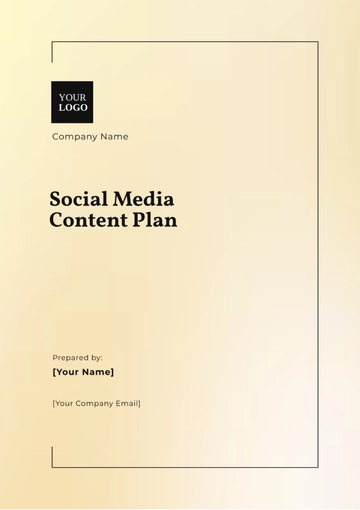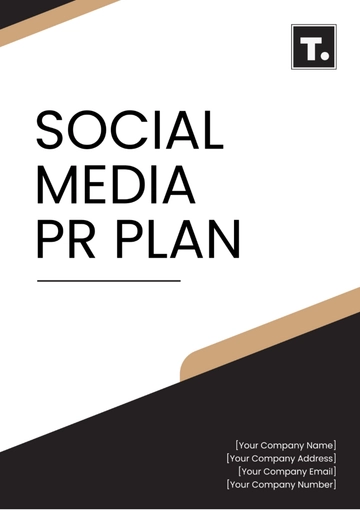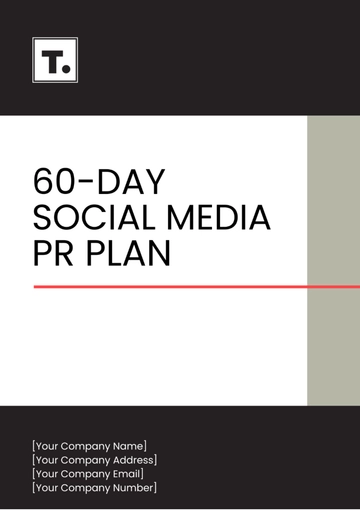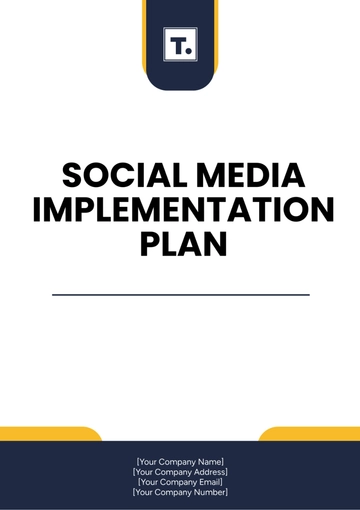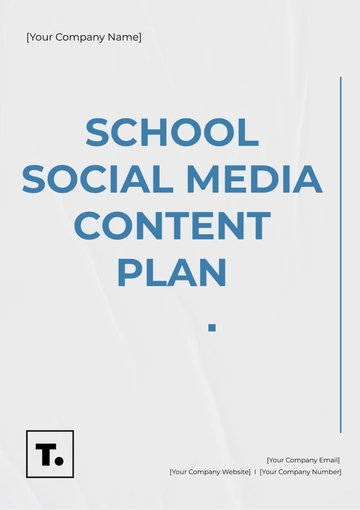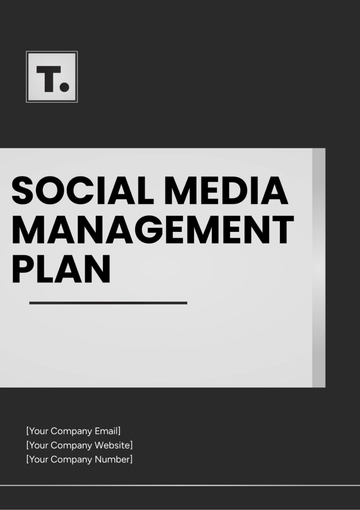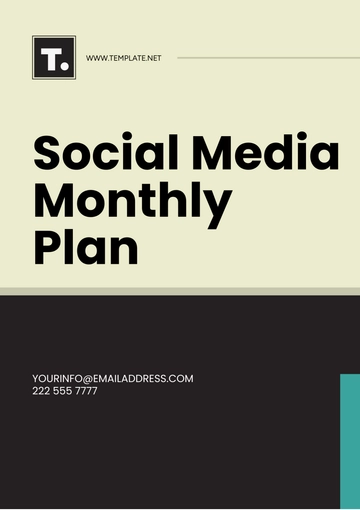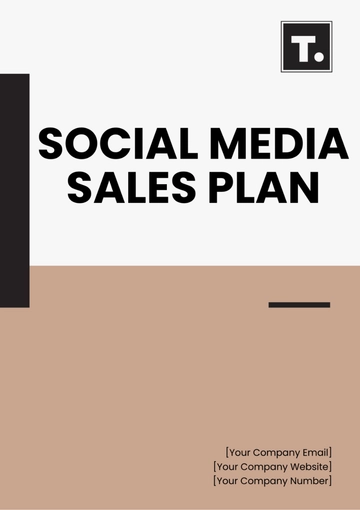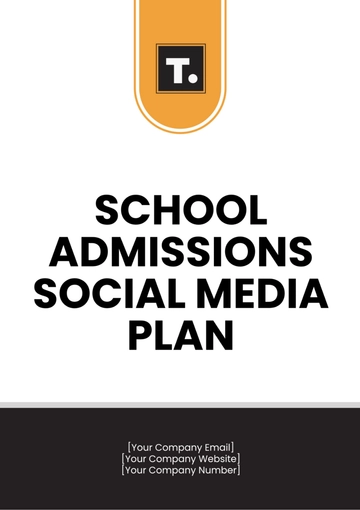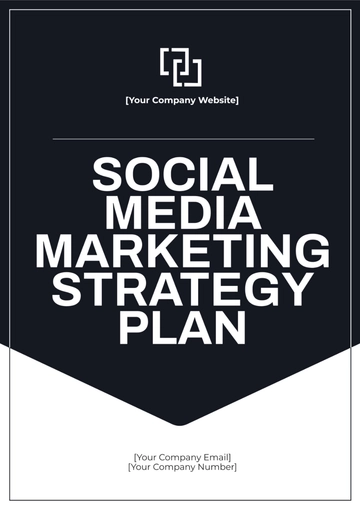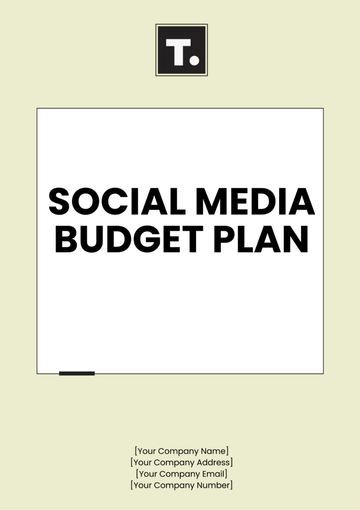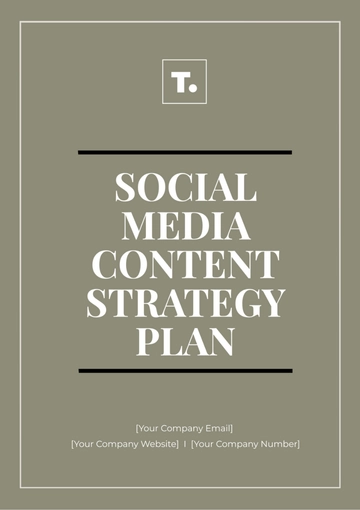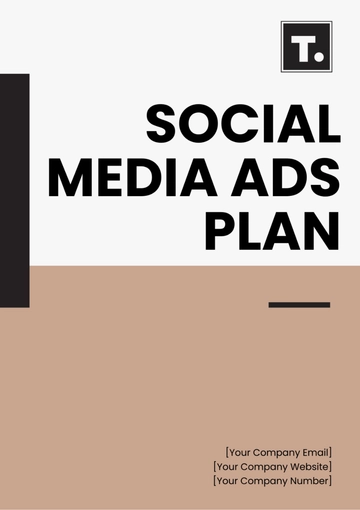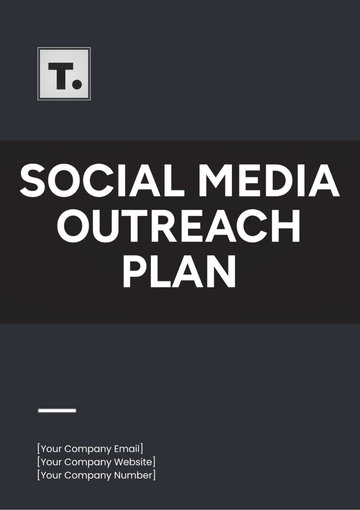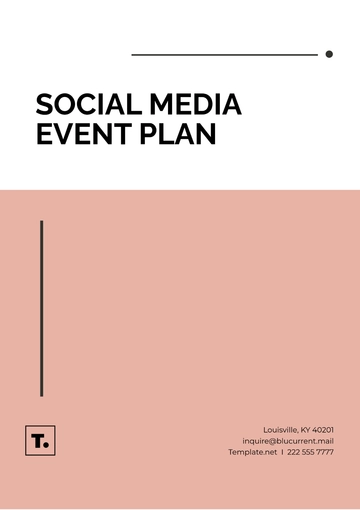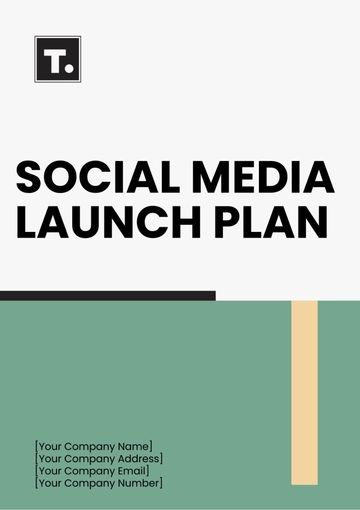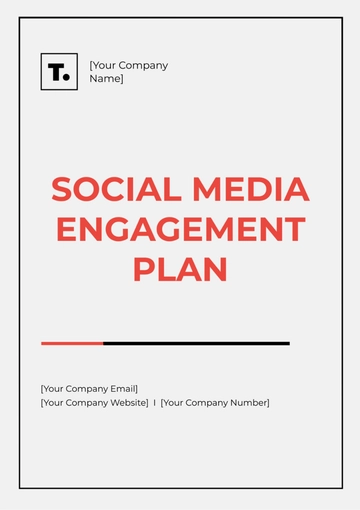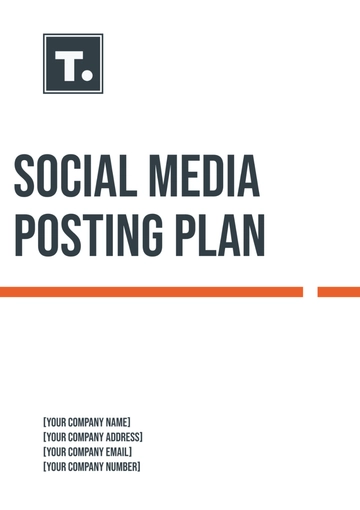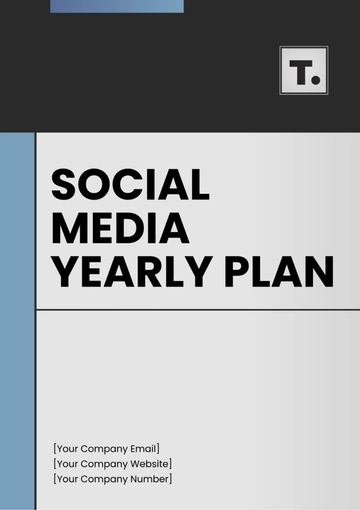Free Social Media Outreach Plan
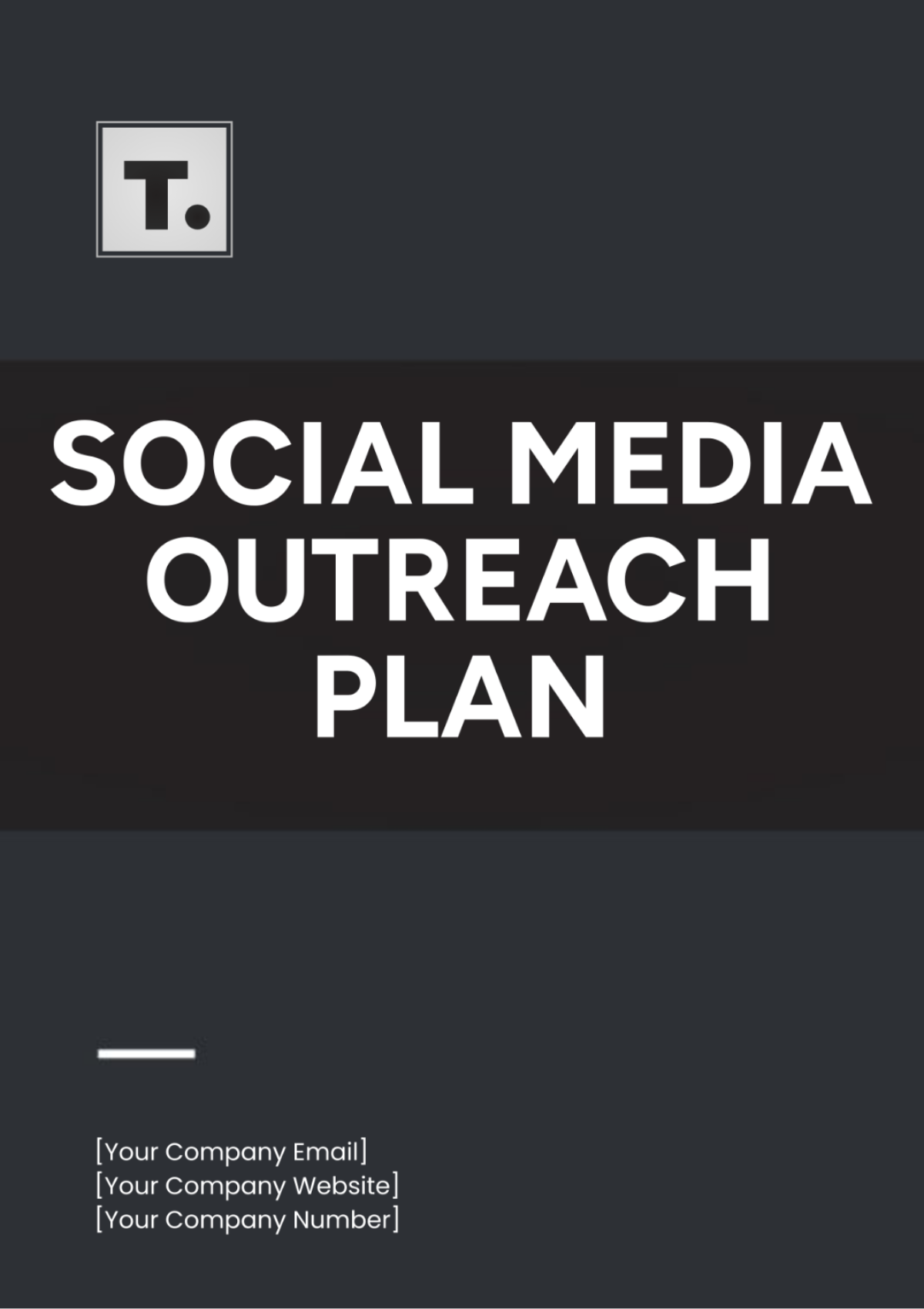
Prepared by: [YOUR NAME]
Contact Email: [YOUR EMAIL]
Company Name | [YOUR COMPANY NAME] |
Contact Person | [YOUR NAME] |
[YOUR EMAIL] | |
Phone Number | [YOUR COMPANY NUMBER] |
Address | [YOUR COMPANY ADDRESS] |
Website | [YOUR COMPANY WEBSITE] |
Social Media Profiles | [YOUR COMPANY SOCIAL MEDIA] |
I. Executive Summary
The Social Media Outreach Plan for [YOUR COMPANY NAME] aims to enhance brand visibility, engage with the target audience, and drive traffic to [YOUR COMPANY WEBSITE]. This plan outlines strategic goals, target audience insights, platform strategies, and performance metrics. With a focus on tailored content and active engagement, we seek to establish a strong online presence and foster meaningful connections with our audience.
II. Goals and Objectives
Increase Brand Awareness: Achieve a [X%] increase in social media followers across all platforms within [X MONTHS].
Boost Engagement: Improve interaction rates by [X%] through targeted content and engagement strategies.
Drive Traffic: Increase website traffic from social media by [X%].
Lead Generation: Generate [X NUMBER] of leads per month through social media campaigns.
Enhance Brand Loyalty: Cultivate a community of brand advocates through consistent engagement and personalized interactions.
Establish Thought Leadership: Position [YOUR COMPANY NAME] as an industry authority by sharing valuable insights and expertise through social media content.
III. Target Audience
Demographics
Age: [AGE RANGE]
Gender: [GENDER]
Location: [GEOGRAPHIC LOCATIONS]
Income Level: [INCOME RANGE]
Education Level: [EDUCATION BACKGROUND]
Occupation: [OCCUPATION]
Interests
Hobbies and Interests: [AREAS]
Social Media Preferences: [PREFERRED PLATFORMS]
Content Preferences: [TYPES OF CONTENT THEY ENGAGE WITH]
Challenges and Pain Points: [CHALLENGES THEY FACE]
Online Behaviors
Activity Times: [PEAK TIMES OF ACTIVITY]
Engagement Habits: [HOW THEY INTERACT WITH CONTENT]
Purchase Behavior: [ONLINE SHOPPING PREFERENCES]
Content Consumption Habits: [WHERE THEY SEEK INFORMATION]
IV. Platform Strategy

Facebook Strategy | |
Content Types | Videos, infographics, blog posts, polls |
Posting Frequency | [NUMBER] times per week |
Engagement Strategy | Respond to comments, create interactive quizzes, share user-generated content |
Instagram Strategy | |
Content Types | Stories, reels, carousel posts, behind-the-scenes footage |
Posting Frequency | [NUMBER]times per week |
Engagement Strategy | Host Instagram Lives, run contests, collaborate with micro-influencers |
Twitter Strategy | |
Content Types | Tweets, threads, images, Twitter chats |
Posting Frequency | [NUMBER] times per day |
Engagement Strategy | Participate in trending hashtags, retweet relevant content, engage in industry discussions |
LinkedIn Strategy | |
Content Types | Articles, professional insights, company updates, LinkedIn polls |
Posting Frequency | [NUMBER] times per week |
Engagement Strategy | Join industry groups, share thought leadership articles, participate in LinkedIn Live events |
V. Content Plan
Content Calendar: Outline of daily, weekly, and monthly content themes with specific posting times
Content Creation: Utilize a mix of in-house and outsourced content creation resources to maintain quality and consistency
Content Approval: Establish a streamlined approval process to ensure content aligns with brand guidelines and messaging
VI. Engagement Tactics
Response Time: Aim to respond to comments and messages within [TIME FRAME]
Interaction: Regularly engage with followers' content through likes, comments, and shares
User-Generated Content: Encourage followers to share their experiences and feature their content on our platforms
Community Building: Initiate discussions, ask questions, and create a sense of belonging among followers.
VII. Influencer Partnerships
Identification: Research and identify influencers whose audience aligns with ours and who resonate with our brand values
Outreach: Personalize outreach messages and establish mutually beneficial partnerships
Collaboration: Co-create content, host joint events, and leverage influencer networks to amplify reach and engagement
VIII. Measurement and Analytics
KPIs: Track metrics such as reach, engagement, conversion rates, sentiment analysis, and customer acquisition cost (CAC)
Tools: Utilize analytics tools like [ANALYTICS TOOL NAMES] to monitor performance and gain actionable insights
Reporting: Generate monthly reports to assess progress, identify areas for improvement, and refine strategies accordingly
IX. Budget and Resources
Budget Allocation: Allocate resources for paid advertising, influencer partnerships, content creation, and social media management tools.
Resource Allocation: Assign dedicated team members to oversee social media efforts and provide necessary training and support.
X. Crisis Management Plan
Risk Assessment: Anticipate potential risks and develop proactive strategies to mitigate them
Response Protocol: Establish clear guidelines for handling negative feedback, complaints, and crises on social media
Communication Plan: Designate spokespersons, draft pre-approved responses, and maintain transparency and authenticity in all communications
XI. Conclusion
The Social Media Outreach Plan outlined above provides a comprehensive framework for [YOUR COMPANY NAME] to effectively engage with our target audience, build brand awareness, and drive business growth through strategic social media initiatives. By leveraging audience insights, employing tailored content strategies, and fostering meaningful relationships, we aim to establish [YOUR COMPANY NAME] as a trusted authority in the industry while delivering value to our audience and achieving our business objectives.
- 100% Customizable, free editor
- Access 1 Million+ Templates, photo’s & graphics
- Download or share as a template
- Click and replace photos, graphics, text, backgrounds
- Resize, crop, AI write & more
- Access advanced editor
Maximize your social media impact with Template.net’s Social Media Outreach Plan Template. This fully customizable and editable template is designed to streamline your strategy. Easily tailor your plan using our AI Editor Tool, ensuring a personalized approach to boost your online presence effectively.
You may also like
- Finance Plan
- Construction Plan
- Sales Plan
- Development Plan
- Career Plan
- Budget Plan
- HR Plan
- Education Plan
- Transition Plan
- Work Plan
- Training Plan
- Communication Plan
- Operation Plan
- Health And Safety Plan
- Strategy Plan
- Professional Development Plan
- Advertising Plan
- Risk Management Plan
- Restaurant Plan
- School Plan
- Nursing Home Patient Care Plan
- Nursing Care Plan
- Plan Event
- Startup Plan
- Social Media Plan
- Staffing Plan
- Annual Plan
- Content Plan
- Payment Plan
- Implementation Plan
- Hotel Plan
- Workout Plan
- Accounting Plan
- Campaign Plan
- Essay Plan
- 30 60 90 Day Plan
- Research Plan
- Recruitment Plan
- 90 Day Plan
- Quarterly Plan
- Emergency Plan
- 5 Year Plan
- Gym Plan
- Personal Plan
- IT and Software Plan
- Treatment Plan
- Real Estate Plan
- Law Firm Plan
- Healthcare Plan
- Improvement Plan
- Media Plan
- 5 Year Business Plan
- Learning Plan
- Marketing Campaign Plan
- Travel Agency Plan
- Cleaning Services Plan
- Interior Design Plan
- Performance Plan
- PR Plan
- Birth Plan
- Life Plan
- SEO Plan
- Disaster Recovery Plan
- Continuity Plan
- Launch Plan
- Legal Plan
- Behavior Plan
- Performance Improvement Plan
- Salon Plan
- Security Plan
- Security Management Plan
- Employee Development Plan
- Quality Plan
- Service Improvement Plan
- Growth Plan
- Incident Response Plan
- Basketball Plan
- Emergency Action Plan
- Product Launch Plan
- Spa Plan
- Employee Training Plan
- Data Analysis Plan
- Employee Action Plan
- Territory Plan
- Audit Plan
- Classroom Plan
- Activity Plan
- Parenting Plan
- Care Plan
- Project Execution Plan
- Exercise Plan
- Internship Plan
- Software Development Plan
- Continuous Improvement Plan
- Leave Plan
- 90 Day Sales Plan
- Advertising Agency Plan
- Employee Transition Plan
- Smart Action Plan
- Workplace Safety Plan
- Behavior Change Plan
- Contingency Plan
- Continuity of Operations Plan
- Health Plan
- Quality Control Plan
- Self Plan
- Sports Development Plan
- Change Management Plan
- Ecommerce Plan
- Personal Financial Plan
- Process Improvement Plan
- 30-60-90 Day Sales Plan
- Crisis Management Plan
- Engagement Plan
- Execution Plan
- Pandemic Plan
- Quality Assurance Plan
- Service Continuity Plan
- Agile Project Plan
- Fundraising Plan
- Job Transition Plan
- Asset Maintenance Plan
- Maintenance Plan
- Software Test Plan
- Staff Training and Development Plan
- 3 Year Plan
- Brand Activation Plan
- Release Plan
- Resource Plan
- Risk Mitigation Plan
- Teacher Plan
- 30 60 90 Day Plan for New Manager
- Food Safety Plan
- Food Truck Plan
- Hiring Plan
- Quality Management Plan
- Wellness Plan
- Behavior Intervention Plan
- Bonus Plan
- Investment Plan
- Maternity Leave Plan
- Pandemic Response Plan
- Succession Planning
- Coaching Plan
- Configuration Management Plan
- Remote Work Plan
- Self Care Plan
- Teaching Plan
- 100-Day Plan
- HACCP Plan
- Student Plan
- Sustainability Plan
- 30 60 90 Day Plan for Interview
- Access Plan
- Site Specific Safety Plan
